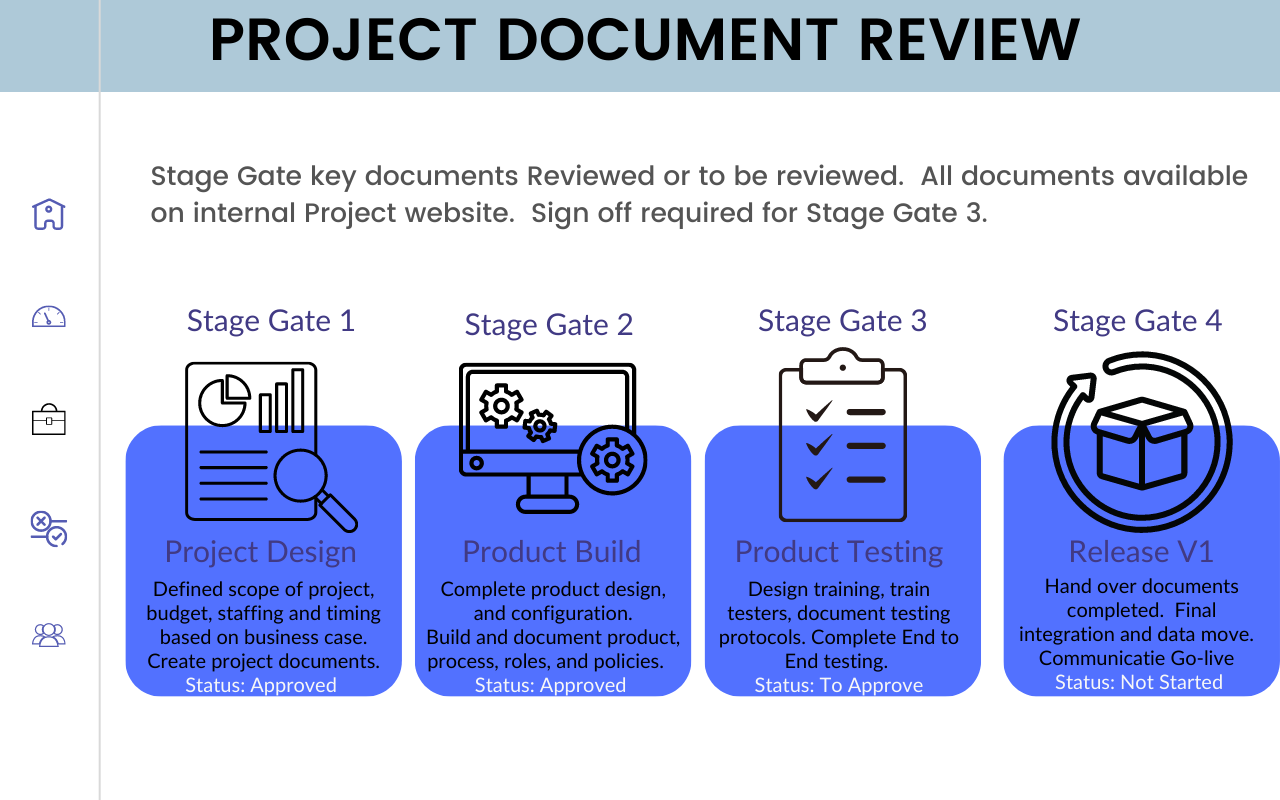Project Governance for Project Managers
How Governance makes your Project better
Aligns goals and outcomes
Confirms roles and responsibilities
Provides authority to act
How to know if your project needs governance?
Project governance is essential for ensuring the success of a project. It establishes a framework for decision-making, risk management, and accountability. Good governance can also help to prevent project failure, reduce costs, and improve stakeholder satisfaction. A well-designed project governance structure can provide the project with the oversight that will protect the project, product and team.
Consider the project's size, complexity, or importance to the company. The final decision may come from the project manager. Organizational or supplier project management rules may also drive the decision.
Why Project Managers want project governance?
While governance might be considered a burden to project teams, it is actually a protection. Governance can ensure your key stakeholders stay involved and document their knowledge and approval of the project as it progresses. Governance can include a review of the:
Project Strategy
Project Execution
Processes and ways of working
Asset purchase decision
Escalation of project issues to be resolved
Stage-Gate (or milestone) approvals
But how does project governance work? Below is a step-by-step overview for governance setup, reporting and meetings.
How to set up a Governance Steering Committee
A governance steering committee is a group of senior leaders responsible for overseeing the project's progress and ensuring it aligns with organizational objectives. Here are the steps to set up a governance steering committee:
Define the committee's purpose, scope, and responsibilities
Identify the committee members, including key stakeholders and subject matter experts
Determine the committee's frequency of meetings and duration of their term
Establish the decision-making process and authority of the committee
Develop a communication plan to inform stakeholders of the committee's activities and decisions
Governance meetings are generally held based on the timing of the project. Meetings could be monthly for projects that will last a year or more. Shorter projects may need more frequent steering meetings.
How to set up Project Governance Reporting
Project governance reporting provides stakeholders with updates on project progress, risks, and issues. Here are the steps to set up project governance reporting:
Define the reporting requirements, including frequency, format, and content
Identify the stakeholders who will receive the reports
Determine the reporting process and establish roles and responsibilities for report generation and distribution
Establish a review process to ensure the accuracy and completeness of the reports
Develop a communication plan to ensure stakeholders know the project's progress
Reporting is important to the governance process. So let's look at an step-by-step example you can use for inspiration.
Summarize the Project Current State against KPI’s
Every governance meeting should start with an overview of the project's health. This can include several aspects of the project, depending on which aspects of project attributes are the focus, see a 1-minute video on the types of project constraints and management models to help you consider your Governance KPIs. This may also include the antidotal input on topics such as user acceptance of the solution and the focus of the current Steering meeting.
Regularly review the project against the business objectives
Document how the project realizes the business value documented at the project's approval. Managers could use the project charter or a summary agreed upon with the Project Owner if no exists. This information baseline and the KPIs should be reviewed and agreed upon at the first steering committee meetings to ensure that the attributes tracked over time are understood and consistently used.
Focus on Stages and documents
Just as Project Managers track project milestones, Managers can also track the status of each approval stage needed for governance review. Documenting what each stage includes helps keep the governing body focused on the aspects of the project currently in review. Summarizing the project in this matter can be helpful to stakeholders with a high-level overview of the project.
Document each meetings input and outcomes
Key to Governance meetings are review, assessment, and decision-making. These points need to be documented for task discussion and final decisions. A summary of this kind of information can be shown as above. Detailed assessment documents will be needed for each of the reviews. See this article and the companion documents (available as free templates for download) for more on how project managers can produce these documents.
Include a summary of who’s who
Documenting the Steering Committee (or SteerCo) can be used to share with others, to establish roles and responsibilities at the first meeting, and to assess if any changes to the SteerCo are needed during the life of the project. The documented information should include the participant's title, role, and how they connect to the project. It helps ensure the governance committee represents a diverse group of senior managers. Each steering member should be willing and able to attend meetings, understand and review project content, and resolve issues to ensure project success.
How to run a Project Governance meeting
A project governance meeting is a forum for discussing project progress, risks, and issues. Here are the steps to run a project governance meeting:
Define the meeting's purpose and agenda.
Invite relevant stakeholders and ensure their availability.
Prepare and distribute meeting materials in advance, including the agenda, minutes of the previous meeting, and project status reports.
Facilitate the meeting to ensure that all agenda items are addressed and discussed.
Document meeting minutes, including action items, decisions, and follow-up tasks.
While the Project Manager is not the final decision maker, they generally prepare and chair (or run) the meetings. Documentation should be sent a day or two before each meeting to allow committee members to read and review any content so they are prepared to discuss and assess the questions they are asked to address. If specific issues impact a governing committee member, call that member to discuss points with them before the meeting. No one likes surprises, so as a Project Manager, ensure you are transparent and clear with all committee members.
A few warnings about governance meetings: Sometimes, these meetings may be adversarial. If there are disagreements among the committee members, the final decision-maker must be clear. In general, this is usually the Project Owner. Project Managers should work closely with the Project Owner to align views before each Steering committee as a practical way to manage issues before they come up in general discussion.
If, during these meetings, additional subject matter experts (SMEs) are asked to provide content for the Steering Group to assess, the committee should limit discussions while team members are present. Project Managers should protect the team. This includes ensuring that committee members do not play the 'blame game' or try to 'scapegoat' project team members. Committee members should not share concerns or disagreements outside the meetings. Doing so could confuse team members, create 'churn,' and is simply unprofessional.
In summary, project governance is crucial for ensuring the success of a project. Setting up a governance steering committee, project governance reporting, and project governance meetings are essential to an effective project governance structure. Many projects also need supplier management for work done as part of the project. Project Managers know managing suppliers is key to their overall success, but quite different than project steering. Read this article for more on supplier management and reporting.







